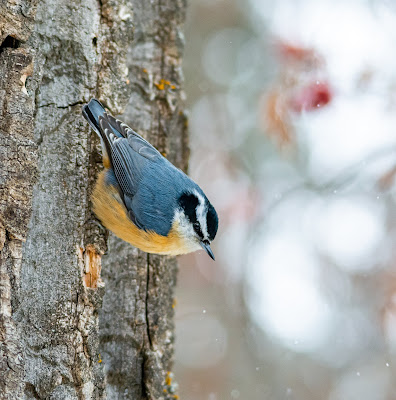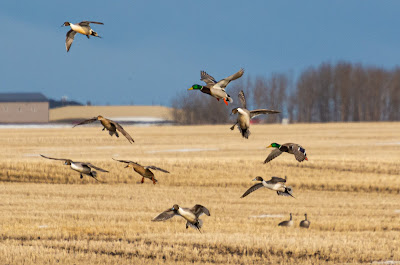Nuthatches: Cute and Tough as Well
You've really got to love nuthatches. Next to the Black-capped Chickadee they're probably the most common small native songbird that Albertans are likely to see in parks and backyard feeders, but nuthatches are still enjoyable to watch and worth getting to know better. There are two species in Alberta that we'll touch on, as well as one just over the border and another more cryptic nuthatch-like bird.
Nuthatches are a bird family of their own, the Sittidae, and in general are small, stubby woodland birds with chisel-shaped bills for getting inside seed casings. They're little balls of energy too, always zipping around looking for food or defending their territory from other breeding pairs. Nuthatches cling to tree trunks almost like tiny woodpeckers. Alberta's two nuthatch species are the Red-breasted Nuthatch (Sitta canadensis) and the White-breasted Nuthatch (Sitta carolinensis). Luckily for novice birdwatchers, they're easy to tell apart. While both are small seed-eating woodland birds that scamper up and down trees, even a quick look can tell you which one is at hand.
 |
| Red-breasted Nuthatch. By Nick Carter |
 |
| White-breasted Nuthatch. By Nick Carter |
First off, at 13-15.5 cm in length the White-breasted is noticeably larger than the Red-breasted (10.2-12.4 cm long). The Red-breasted Nuthatch is a little round bird with a long beak and stubby tail. Its white head is barred with black eyelines and crown. The upper parts beyond the nape are a simple blue-grey colour, while nearly the whole underside is a pale rusty shade. The slightly more elongate White-breasted Nuthatch has a clean white face and belly, aside from some chestnut patches on the lower abdomen and undertail. The top of the head and neck are black, and like the Red-breasted the dorsal side is bluish grey.
In both species the call is a soft, nasally yank sound, but it tends to be more high-pitched in the smaller Red-breasted Nuthatch. These calls are an easy way to detect nuthatches while out on a walk. Once you hear that distinctive sound, pause and look up on the surrounding trunks and chances are you'll see one scurrying across the bark or flitting from tree to tree. To find nuthatches, especially during the winter, I often find it easiest to look for chickadees first. Flocks of Black-capped Chickadees make no secret of their presence as they buzz around the woods foraging. Oftentimes, especially with urban park chickadees used to being fed by people, they'll fly in to check you out and just as often as not, they'll have a nuthatch or two accompanying them. Since both birds share a similar diet, wherever the hard-working chickadees are finding success, nuthatches can probably get a meal as well. Plus, chickadees make and excellent alarm system if a hawk or owl decides to drop by.
Also like chickadees, nuthatches will happily visit backyard feeders and other such places for easy winter meals. After sifting through the offerings for a seed, they take their morsel up to a branch where the stout beak pecks through the shell to get at the nutritious seed within. This habit, though shared with other birds, is where nuthatches get their name. They'll also stash seeds in wooden crevices and such for later.
 |
| White-breasted Nuthatch with a seed. By Nick Carter |
 |
| Nuthatches will happily grab seeds from the ground as well as up high. By Nick Carter |
Nuthatches are renowned for their ability to scurry up, down, and sideways across tree trunks with ease thanks to their impressively large, hook-shaped claws. Their flexible neck-bending pose while gripping upside-down to the bark is a classic nuthatch image. Unlike woodpeckers, though, they don't brace themselves against tree trunks with their tail feathers. Red-breasted Nuthatches show an interesting behaviour during the nesting season in which they smear sticky tree resin around the edge of the nest cavity. It's thought that this might deter predators from sneaking into the nest.
 |
| Classic nuthatch pose. By Nick Carter |
Alberta residents in most major towns and cities can expect to see both nuthatch species year-round, though they tend to be more noticeable in the winter once the flashier birds are gone and they need to work harder to find food. Despite their size, nuthatches manage to endure our coldest conditions with admirable fortitude. Like other year-round songbirds, nuthatches stay alive thanks in part to their thick, insulating down feathers (which are even warmer than mammal fur) and feeding often throughout the day to power their highly energetic metabolisms. Sheltering in a hole or notch in a tree keeps them out of nasty storms.
It's not uncommon to see both Red-breasted and White-breasted Nuthatches right in the same spot where their ranges overlap. Despite Red-breasted probably being the more common species, I find I tend to see White-breasted slightly more often.
 |
| Nuthatches will even sift through leaves on the forest floor for seeds that might wind up there. By Nick Carter |
While the ranges of both birds overlap significantly, Red-breasted Nuthatches are more widespread, occupying just about every corner of Alberta from the far-northern boreal forest to the dry southern prairies. White-breasted Nuthatches are more confined in their ranges, generally sticking to the poplar woods of Alberta's parkland regions as well as the central and southern Rockies. This means that folks from Peace River down through Edmonton, Red Deer, and Calgary can bet on seeing this species, but folks in the more coniferous far north will be more hard-pressed. It's interesting to note how our understanding of the range of the White-breasted Nuthatch has changed over the years. Early guides such as Salt and Wilk's The Birds of Alberta from 1958 found little in the way of data on this species from the province at all, and subsequent range maps indicate their presence more and more in central and western Alberta. Were they really all but absent from the province until the past 60 years or so, or were they always abundant and people never took much notice until relatively recently?
 |
| Nuthatches. By Nick Carter |
Just over the border in south-central British Columbia is Canada's third nuthatch species, the Pygmy Nuthatch (Sitta pygmaea). This small species, at 9.4-11.3 cm in length, can be found in the warm ponderosa pine woods of the Okanogan Valley. I was pleased to spot a pair myself just south of Vernon a couple years back. They're a relatively plain-coloured nuthatch, with a white throat, tan belly, brown head and blue back. Their size can make them hard to spot in the giant pines, so listen for their high, piping calls chittering away up high.
 |
| Pygmy Nuthatch. By Nick Carter |
One final bird that might look like a tiny nuthatch but isn't one is the Brown Creeper (Certhia americana). It's member of a different family, the Certiidae. Roughly the size of a Red-breasted Nuthatch, they range from 12.5-14.5 cm long. Like nuthatches, the Brown Creeper 'creeps' up tree trunks in that horizontal woodpecker-posture. Instead of seeds, however, creepers mostly hunt for small insects that take shelter in the nooks and crannies of tree bark using their long, curved beak. A closer look at a creeper reveals a bird that resembles a wren more than a nuthatch in appearence, with its curved beak, longish tail, mottled brown top side and pale white underside. Like woodpeckers, creeprs use their stiff tail feathers as a climbing support.
 |
| Brown Creeper. By Nick Carter |
Their small size and cryptic colouration means that Brown Creepers can be frustratingly hard to find, as they blend right into the bark of the big, mossy trees they prefer to climb. They frequent old growth forests across the central Alberta parkland and mountains, but due to their secretive nature their full range has long been a bit of a mystery. I've seen them as far north as Grande Prairie. To find a Brown Creeper, go on a winter walk in your nearest old, quiet forest and either wait to spot what looks like a fleck of bark shimmy up a tree or listen for the thin, high-pitched whistle of a nearby creeper. It's just a matter of patience, sharp eyes, and luck. That said, creepers can also appear in strange places. My best creeper sighting was when one randomly appeared in the trees outside my apartment window and just stuck around for much of the day. You never know.
 |
| Photographing nuthatches leads to some interesting views. By Nick Carter |
So that's nuthatches and nuthatch-like things for you. Sometimes birding is about tracking down that elusive, rare species that you've been dying to see for ages. And sometimes it's about enjoying the everyday, reliable ones that are always ready to bring some cheer to the neighborhood. Enjoy both.





Comments
Post a Comment